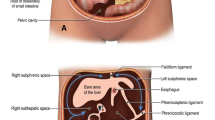Abstract
Background
Nonoperative management is now regarded as the best alternative for the treatment of patients with complex blunt liver injuries. However, some patients still require surgical treatment for complications that were formerly managed with laparotomy and a combination of image-guided studies.
Methods
We reviewed the medical records of 15 patients who had complex blunt liver injuries that were managed nonoperatively and in which biliary peritonitis developed.
Results
Delayed laparoscopy was performed 2–9 days after admission in patients with extensive liver injuries. All 15 patients had developed local signs of peritonitis or a systemic inflammatory response. Laparoscopy was indicated to drain a large retained hemoperitoneum (eight patients), bile peritonitis (four patients), or an infected perihepatic collection (three patients). Laparoscopy was successful in all patients, and there was no need for further interventions.
Conclusion
The data indicate that as more patients with complex liver injuries are treated nonoperatively and the criteria for nonoperative management continue to expand, more patients will need some type of interventional procedure to treat complications that historically were managed by laparotomy. At this point, laparoscopy is an excellent alternative that should become part of the armamentarium of the trauma surgeons who treat these patients.
Similar content being viewed by others
References
Cachecho R, Clas D, Gersin K, Grindlinger GA (1998) Evolution in the management of the complex liver injury at a level I trauma center. J Trauma 45: 79–82
Carrillo EH, Platz A, Miller FB, Richardson JD, Polk HC (1998) Non-operative management of blunt hepatic trauma. Br J Surg 85: 461–468
Carrillo EH, Richardson JD (1999) Delayed surgery and interventional procedures in complex liver injuries [Editorial]. J Trauma 46: 678–679
Carrillo EH, Spain DA, Wohltmann CD, Schmieg RE, Boaz PW, Miller FB, Richardson JD (1999) Interventional techniques are useful adjuncts in the nonoperative management of hepatic injuries. J Trauma 46: 619–622
Croce MA, Fabian TC, Menke PG, Waddle-Smith L, Minard G, Kudsk KA, Patton JH Jr, Schurr MJ, Pritcharol FE (1995) Nonoperative management of blunt hepatic trauma is the treatment of choice for hemodynamically stable patients: results of a prospective trial. Ann Surg 221: 744–753
Feliciano DV (1992) Continuing evolution in the approach to severe liver trauma. Ann Surg 216: 521–523
Feliciano DV, Pachter HL (1989) Hepatic trauma revisited. Curr Probl Surg 28: 458–524
Gable DR, Allen JW, Harrel DJ, Carrillo EH (1997) Endoscopic treatment of postraumatic "bilhemia": case report. J Trauma 43: 534–536
Giacomantonio M, Filler RM, Rich RH (1984) Blunt hepatic trauma in children: experience with blunt hepatic trauma in children. J Pediatr Surg 19: 519–522
Goan YG, Huang MS, Lin JM (1998) Nonoperative management for extensive hepatic and splenic injuries with significant hemoperitoneum in adults. J Trauma 45: 360–365
Goff CD, Gilbert CM (1995) Nonoperative management of blunt hepatic trauma. Am Surg 61: 66–68
Harrell DJ, Vitale GC, Larson GM (1998) Selective role for endoscopic retrograde cholangiopancreatography in abdominal trauma. Surg Endosc 12: 400–404
Jaeshke J (1996) Chemokines, neutrophils, and inflammatory liver injury. Shock 6: 403–404
Moore EE, Cogbill TH, Jurkovich GJ, Shackford SR, Malangoni MA, Champion HR (1995) Organ injury scaling: spleen and liver (1994) revision. J Trauma 38: 323–324
Oldham KT, Guice KS, Rykham F (1986) Blunt liver injury in children: evolution of therapy and current perspective. Surgery 100: 542–549
Pachter HL, Hofstetter SR (1995) The current status of non-operative management of adult blunt hepatic injuries. Am J Surg 169: 442–454
Pachter HL, Liang HC, Hofstetter SR (1996) Liver and biliary tract trauma. In: Feliciano DV Moore EE Mattox KL (eds) Trauma. Appleton & Lange, Stamford, CT, pp 487–523 3rd ed.
Richie JP, Fonkalsrud EW (1972) Subcapsular hematoma of the liver: nonoperative management. Arch Surg 104: 781–784
Sherman HF, Savage BA, Jones LM, Barette RR, Latenser BA, Varcelotti JR, McAuley CE, Jones RT, Myers AH (1994) Nonoperative management of blunt hepatic injuries: safe at any grade? J Trauma 37: 616–621
Steiner Z, Brown RA, Jamiesson DH, Milar AJW, Cywes S (1994) Management of hemobilia and persistent biliary fistula after blunt liver trauma. J Pediatr Surg 29: 1575–1577
Ward PA, Lentsch AB (1999) The acute inflammatory response and its regulation. Arch Surg 134: 666–669
Author information
Authors and Affiliations
Rights and permissions
About this article
Cite this article
Carrillo, E.H., Reed, D.N., Gordon, L. et al. Delayed laparoscopy facilitates the management of biliary peritonitis in patients with complex liver injuries. Surg Endosc 15, 319–322 (2001). https://doi.org/10.1007/s004640000300
Received:
Accepted:
Issue Date:
DOI: https://doi.org/10.1007/s004640000300




